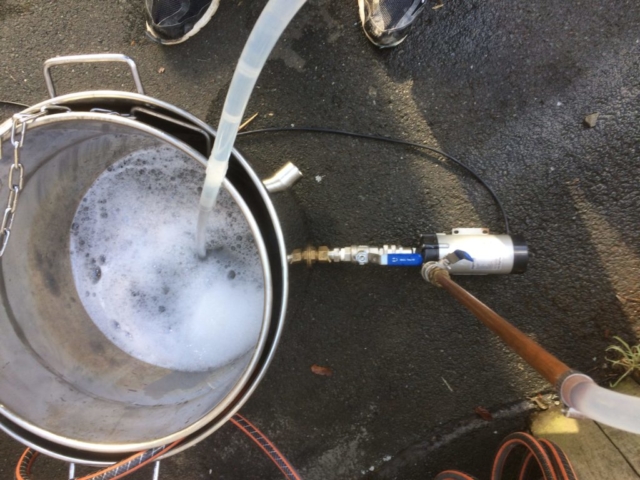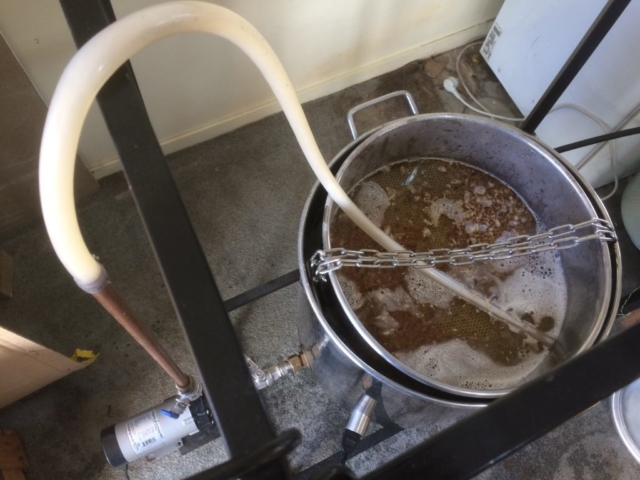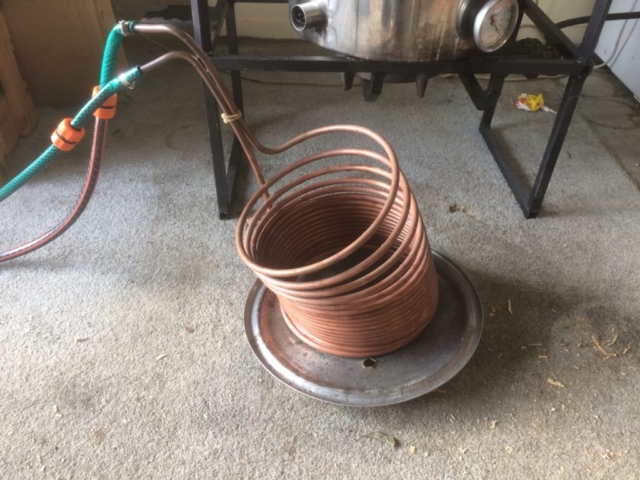A Brew day with my R.I.M.S
Step 1. Get some Grains
I like to support small business so I head over to the Auckland Brewers Co-op https://www.brewerscoop.co.nz . Over the last two years I have been constructing really basic beers to try work out kinks in my process and find improvements to my machine but today I decided to go with something a little more regular, my favorite style; Amber Ale. My grain bill for today was rather haphazardly googled on my way to the brew shop and converted on the fly with the (very patient) gentleman working the grain room at the time.
I adapted Max’s last call  to fit a NZ grain and hop bill.
Particularly important with R.I.M.S is avoiding a  ‘Stuck’ mash, when this happens in R.I.M.S. it ruins the whole system. “Stuck” means that there has been too much pressure or you have put too much volume into your mash so it forces the mash down and drastically reduces wort / liquor flow.  So I bought 600 grams of Oak Hulls. I have never seen these before but there was a bag for sale so I thought I’d try it. Now I never want to brew without them! I mixed them into my grain bill and I was very impressed.
Ingredients in hand, it’s time to get the machine out.

Step 2. Sanitize
Once the machine is out I want to make sure it’s all still cleaned and sanitized. Technically you don’t need to sanitize your mash setup but I like to for good measure.
Step 3. Get Liquor up to strike temp
I lift the inner pot out of the bigger pot and start heating up a bunch of water using the 3 ring burner. I’m normally aiming for 76- 80 degrees Celsius for my strike temperature or so as I want to try bounce between 60 and 70 degrees for my mash.
Using a STC1000 with a thermowell and the manual thermometer I was happy to see they aligned in their temperature. Thanks to Sadu on the homebrewtalk forums for his suggestion that putting the probes into the wort would affect the probe, I installed a thermowell and replaced my probe with a replacement from RS components which was a fucking pain in the arse to get . Honestly, these guys send me the biggest fucking cardboard pamphlets advertisements every other month, but can’t send me 10 grams of temperature probe for less than $50 USD. Come on, guys 🙁
Once the Liquor is up to temperature I lower the mash tun into the boil pot and top up with additional water if required. Then manage the temperature and wort flow with the STC1000 and playing around with the valves respectively.
Step 4. Mash
I have a stainless steel mesh lid on top of the grain bed to help distribute the hot liquor and avoid wells. This and the oat hulls really helped avoiding a stuck mash, I am very pleased with this result.
Step 5. Vorlauf and Sparge
I use the winch (because a 40L pot of Grains and Wort is remarkably heavy!) to raise the grain slowly out of the boil pot and let the pump run for a bit longer to keep everything fluid then I turn that off and use the Quick Disconnects to remove the pump and hoses and set those aside for cleaning. A quick note on Quick Disconnects: I love them. I was on the fence for a while because of the cost but I found some for under $10 each and I am so happy with them. They really make any brew system 10x easier to manage.

Then I boil my kettle and slowly sparge with that as many times as I feel necessary. I would really like to get a second hand Zip style 10L water boiler mounted above the current system but I haven’t found one at the right price yet, so household kettle does it for now.
With the grains sufficiently rinsed it’s reasonably easy to remove from the winch hook and dispose of appropriately. Time to boil.
Step 6. Boil
The easiest part. Just wack the burner back on.

I have removed the STC1000 probe, the element cable and the pump to avoid any heat damage to any of those components. I was a little concerned about the thermometer but it didn’t have any issue. In this particular recipe I added 5G of hops at 5, 15, 25, 35 minutes and 35g at 45 and 55 minutes. This is just my particular taste, I am no longer keen on ridiculous amounts of hops and bitterness. I am using Taiheke Hops which is basically New Zealand Cascade hops. Initial taste tests (1 week in fermenter ) seem positive. Always improving though 🙂
Time to Finish the boil.
Step 7. Cooling
5-10 minutes before the end of the boil I dunk my cleaned copper immersion chiller into the boiler. This way if there is any residue on the coil it will boil off and remain nice and sanitary. I use garden hose at full speed for about 10-15 minutes then drop the pressure down and start using the coil itself to agitate the wort to help cool it faster. I usually aim to get it down to about 30 -40 degrees before putting it in the fermenter, I seem to get quite drastic diminishing returns using immersion chillers and it takes a long time to get to fermentation temperature like this.
Important note, always test your wort chiller before using! A kink or blocked hose will literally spray boiling water all over you and your house, I have done this, it is bad.
Step 8. Into the Fermenter
OK maybe this is the easiest part. I just rotate the boiler around and open the tap and admire the glorious wort.
I then chuck the fermenter straight into the fridge to get down to a reasonable fermenting temperature.
Step 9. Clean up
I have been cleaning things as I go so this last part is a cinch, I just hose off all the remaining parts trying to remove any visible leftovers and then scrub down with a kitchen sponge. Then put it away for next time.

Special Thanks
Thanks to jekeane, acidrain, Sadua and Nokie from the HomebrewTalk Forums for ideas to help get this machine working better.Â
I am always looking for improvements so please feel free to drop a comment if you have any ideas 🙂

























